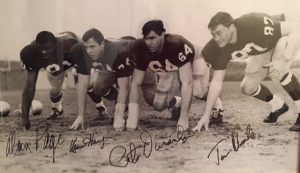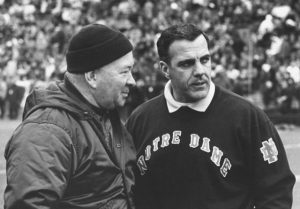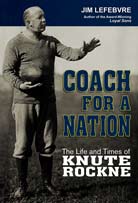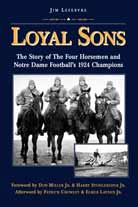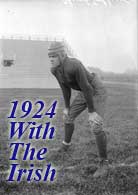The names roll off the tongue like it’s a Sunday morning in 1966, and Lindsay Nelson is bringing the nation yesterday’s Notre Dame football triumph.
Terry Hanratty. Jim Seymour. Rocky Bleier. Nick Eddy. Larry Conjar. Alan Page. Kevin Hardy. Jim Lynch.
Can it really be 50 years? How many kids across the Midwest – and the nation – sat mesmerized in front of their TV sets – many in black-and-white, marveling at this team? This was the team! This was the school! There’s no place like Notre Dame. There simply couldn’t be.
The 1966 Fighting Irish rank with the all-time greats. Yes, it’s unfortunate that so many general sports fans can only name the epic 10-10 tie with Michigan State, which brought controversy along with a consensus national championship.
This Saturday evening, when dozens of 1966 team members, along with their venerable head coach, 93-year-old Ara Parseghian, take the field at Notre Dame Stadium, the memories will come flooding back. Michigan State is the guest. How could it be otherwise?
Amazingly, 12 players off that team received some kind of All-American recognition, including eight on at least one selector’s first team. Many went on to careers in pro football.
One need only look at the defensive production to know this squad was special. They allowed 38 points – for the season. More than a third, 14 points, came in the opener, a 26-14 win against No. 8 Purdue, led by Bob Griese. There were the 10 points yielded to MSU. Single touchdowns to Northwestern and Navy.
And six shutouts. In 10 games, Wins over Army (35-0), North Carolina (32-0), No. 10 Oklahoma (38-0), Pittsburgh (40-0), Duke (64-0) and No. 10 Southern Cal (51-0), the latter the most one-sided result in that series history.
The defense was led by a staunch front four, featuring three All-Americans: Alan Page at one end, and Kevin Hardy and Peter Duranko at the tackles. The other starting tackle, Tom Rhoads, marveled at the talent – and spirit – of the Irish as he spoke to us this week.
“We just had a great group of guys,” said Rhoads. “We love one another; we watch out for one another. We might see one another only once every five years, but you’re still thrilled to see whoever is still standing,” Rhoads said.
“You couldn’t ask for a better group of guys – and some pretty good football players too.”
Sadly, one teammate “no longer standing” is Duranko, who died in 2011 after a decade-long battle with amyotrophic lateral sclerosis (Lou Gehrig’s disease).
“While he was still with us, we had a roast for Pete in his hometown of Johnstown, PA,” Rhoads said. “In the middle of winter, about 25 of the guys made their way there. It was a special tribute.”
Hardy will not make this weekend’s reunion, owing to recent health problems. And Alan Page chose long ago not to include football reunions on his extremely busy schedule, which has included a Hall of Fame career with the Minnesota Vikings, and a long, distinguished law career culminating in some 20 years on the Minnesota Supreme Court, including several years as Chief Justice. Page also founded the Page Education Foundation, which provies financial and mentoring assistance to students of color in exchange for those students’ commitment to further volunteer service in the community.
Members of the 1966 team have gone on to success in a number of fields. Backup defensive end Dr. Alan Sack has had a long career as a professor at the University of New Haven, and has served as president of the Drake Group, whose mission is to “defend academic integrity in college sports, especially during a period of unprecedented commercialism.”
Few career paths are as interesting as Tom Rhoads, though. He was in real estate, then worked as a finance director of a high-end car dealership. “Sales were decreasing, which means income was decreasing. It was time to look for something else.”
With son Tom Jr., a former Duke football player, Rhoads began researching other business opportunities. “We developed five full-blown business plans, but when it was go/no go time, there was always some reason not to proceed. Then my daughter in California mentioned that pet resorts were becoming a big thing out there.”
So the next business plan centered on high-end pet care, and the result was the 20,000-square foot facility in Raleigh, N.C., called Suite Paws Pet Resort & Spa. “We opened in October 2008, as the world was coming to an end,” Rhoads laughed, referring to the recession. “But we survived. And have grown from there. We’re opening our first franchise, in Durham, N.C., and are looking to set up in Cincinnati.”
For all members of the ’66 Irish, Coach Parseghian provided guidance that stood the test of time. That’s true for All-Americans, reserves, even the senior student trainer.
That was the role of Joel Maturi, a fine athlete from Chisholm, MInn., whose injuries precluded a playing career with the Irish. “I always had an ambition to coach. I remember, after Ara was hired in 1964, walking across campus as a freshman, going to see him, to see if I could have a role with the team. He welcomed me, and for that I will always be grateful.
“I probably learned more (about coaching) than if I had been a player,” Maturi said. “I could be in on both the offensive and defensive meetings. Learning everything I could. Much of how I later coached – such as how I approached a game – I learned by being around Coach Parseghian. The discipline, expectations, motivation, response to adversity. How he earned the respect of his players and staff. It was all invaluable.”
Maturi went on to a highly successful coaching career at Madison (Wis.) Edgewood High School, then became assistant and later associate athletic director at the University of Wisconsin. He oversaw the resurgence of Badger football under former Notre Dame assistant coach Barry Alvarez.
From Wisconsin, Maturi became athletic director at the University of Denver, Miami (Ohio) and finally the University of Minnesota, from which he retired after 10 years in 2015. At each stop, lessons learned from Notre Dame days came into play.
He recalled the time in 1966 when the super sophomores – Hanratty and Seymour – were pictured on the cover of Time magazine. “Coach was not happy about it,” Maturi recalled. “Nothing against those two, but he would have preferred his seniors get the publicity….Lynch, Page, Eddy.
“So he cooked up a plan at the next practice, whereby he would come down hard on the two sophomores, so they wouldn’t get a ‘big head.’ But he made sure that Coach (Tom) Pagna and Coach (Joe) Yonto would speak to them after practice, and build them back up. His thinking was, we can’t have a young man walking back to his dorm feeling bad about himself. Great coaches just know things like that. And I’ve shared that story with coaches I have supervised over the years.”
Looked at that way, lots of student-athletes in lots of places have learned from the wisdom and leadership of Coach Parseghian. For the members of the 1966 Fighting Irish, it all added up to a season that will be celebrated as long as football is played at Notre Dame.
